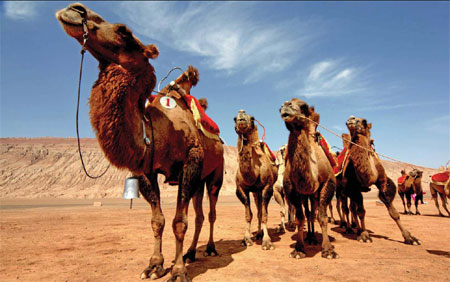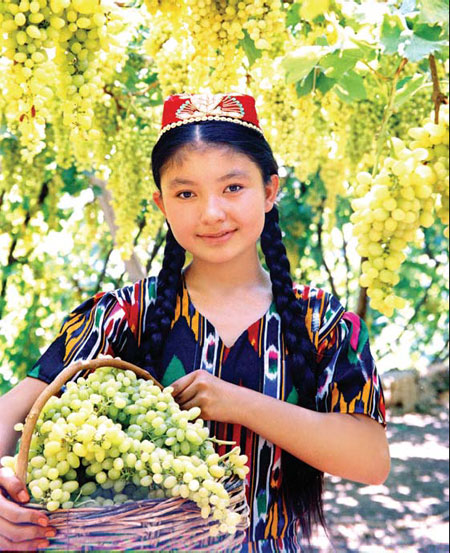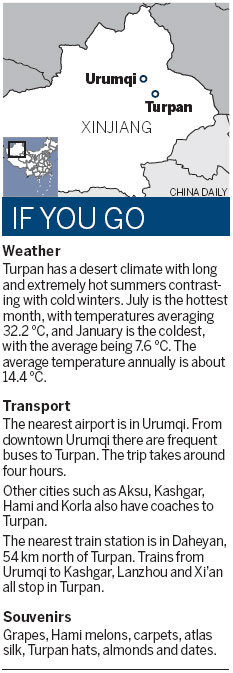Grape expectations
Updated: 2013-02-22 09:44
By Li Aoxue (China Daily)
|
|||||||||||

|
Top: A flock of camels near the Flaming Mountains. Above: A young Uyghur woman in the harvest season in the Grape Valley. Photos Provided to China Daily |
|
|
Located on the Silk Route's northern passage, along which merchants once transported wares between East and West, and in a fertile oasis amid one of China's most arid regions and where part of the world's best grapes are grown, Turpan, has long been a place for travelers and conquerors.
During the Han Dynasty (206 BC - 220 AD) Turpan changed hands several times between the neighbouring nomadic Xiongnu and the Han, with short periods of independence in between their rule.
At other times it was fought over between different kingdoms.
Its name has also changed with the times. In 640AD it was renamed Xizhou by the Tang after their armies conquered the city.
Despite the history of conflict, Turpan's location meant it remained an important part of the Silk Route, and was home to many inns and eateries catering to merchants and other travelers.
Turpan has long been known for its grapes. In the 19th Century, Russian explorer Grigory Grumm-Grzhimaylo said the raisins from Turpan may be the best in the world, and noted the "peculiarly designed buildings" used for drying them.
The secret to Turpan's good grape harvest is the heat and dryness of the region's summer, combined with an ancient irrigation system that also produces good apricots and sweet melons.
In summer, the temperature can reach as high as 47C, and on the surface of the sand as much as 82C . It is no exaggeration to say that people can fry an egg on the hot sand.
Rain is rare, with just just 10 mm falling a year and sometimes ten months can pass without any.
Days are hot and sunny, but temperatures can fall significantly at night.
Here are some of Turpan's top attractions:
1. Ruins of Jiaohe City
Atop a steep cliff, on a leaf-shaped plateau, between two deep river valleys around 10 kilometers from Turpan, Jiaohe City was a natural fortress.
The city is thought to have been the frontier of the outer Cheshi Kingdom during the Han Dynasty.
Jiaohe City was built on an island at the confluence of two rivers, occupying an area of 230,000 square meters.
Most of the remaining buildings are from the Tang Dynasty, and include temples, homes, and administrative buildings.
The ruins have been well preserved by the region's hot, dry climate. No windows face the street and most of the buildings are dug into the earth, both unusual features for the Tang Dynasty.
There are also no city walls because Jiaohe was surrounded on three sides by cliffs, which acted as a natural defense, although not strong enough to hold back the Mongol invasion led by Genghis Khan in the 13th Century, which led to its destruction and abandonment.
2. Flaming Mountains
The Flaming Mountains are red sandstone hills to the east of Turpan, which belong to the Tianshan Mountain range.
Their striking gullies and trenches, caused by erosion of the red sandstone, gives the mountains a flaming appearance at different times of the day.
The mountains are roughly 100 kilometers long and 5-10km wide, crossing the Turpan Depression. They reach an average height of about 500 meters, with the highest peaks above 800m.
They are the hottest place in China, with temperatures frequently reaching 50C or higher.
One of the world's largest thermometers is stationed at the mountains and is a popular tourist attraction.
3. Grape Valley
On the western side of the Flaming Mountains in the Turpan Depression, Grape Valley is crisscrossed by irrigation ditches and dense with trees.
It is made up of more than 200 hectares of grape, which has been grown here for more than 1,000 years.
With a cool and moist climate, it makes a pleasant place to visit in the summer months and an excellent spot to buy Turpan's seedless grapes.
(China Daily 02/22/2013 page23)
Today's Top News
List of approved GM food clarified
ID checks for express deliveries in Guangdong
Govt to expand elderly care
University asks freshmen to sign suicide disclaimer
Tibet gears up for new climbing season
Media asked to promote Sino-Indian ties
Shots fired at Washington Navy Yard
Minimum growth rate set at 7%
Hot Topics
Lunar probe , China growth forecasts, Emission rules get tougher, China seen through 'colored lens', International board,
Editor's Picks

|

|

|

|

|

|







